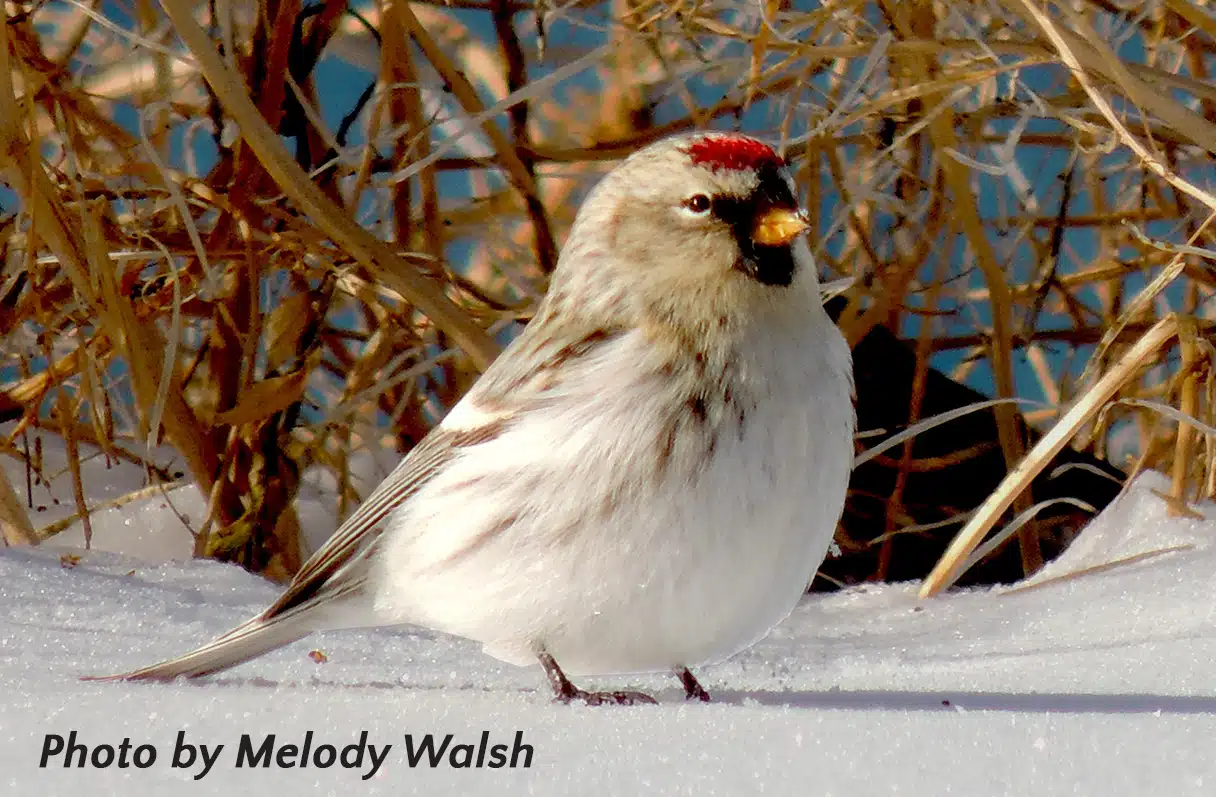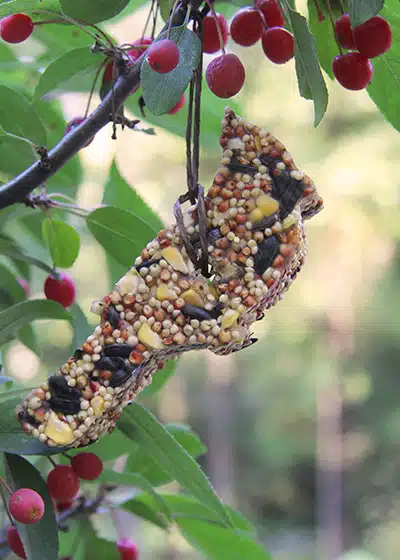FOR THE BIRDS...
Don't forget to pick up your FREE birdseed ornament kit at the Land Trust office, 217 N. 4th Ave. in Sturgeon Bay on Mon., December 19 from 9:30am-4pm. Warm up with some hot chocolate, too!

During the winter months, birds rely on backyard feeders as an essential source of food. Nutritious foods that are rich in oil and carbs provide the calories to help them stay warm and healthy. Remember that clean water is as important as food. Consider a heated birdbath to keep water from freezing.
THE BEST FOOD FOR BACKYARD BIRDS IN WINTER
BLACK OIL SUNFLOWER SEEDS are larger seeds with more calories per seed. They are popular among a wide range of birds, like Northern Cardinals, nuthatches, and jays.
GRATED MILD CHEDDAR CHEESE is favored by a wide range of birds.
MIXED SEEDS are a great overall option and an easy way to start feeding birds in winter. Watch out for mixes containing mostly oats and milo—birds don’t eat these grains.
FRUIT—like apples and pears—chopped into small chunks. Even badly bruised fruit will go down well.
UNSALTED PEANUT BUTTER is a high calorie food loved by a variety of birds. IT MUST BE UNSALTED as salt can be toxic. Spread it into the crevices of a large pinecone and hang it from a tree.
MEALWORMS are a favorite for backyard birds, especially chickadees, nuthatches, woodpeckers, cardinals and the American Robin. Live mealworms have a higher nutritional content over dried. But dried mealworms are easier to store and won’t crawl off the bird feeder.
CRACKED CORN is a versatile foodstuff and is often found in bird seed mixes. Cracked corn is a starchy, carbohydrate-rich option for feeding ground birds such as doves, quail, and turkeys all winter long.
NYJER THISTLE SEEDS are favorites for redpolls, siskins, and other winter finches. Best served in a “sock” feeder.
EGGSHELLS are high in calcium, a mineral sometimes difficult to find in nature, which leaves many birds deficient. Female birds need calcium to create the shells for their eggs. How to serve: Rinse egg shells, then bake them in the oven at 450ºF for 10 minutes. Once cool, crush and add to your bird table, or scatter them on the grass.
10 FOODS THAT ARE HARMFUL TO BIRDS
SPOILED SEED: Birdseed can go bad if it is improperly stored or allowed to rot in poor conditions, and the bugs, mold, and bacteria in spoiled seed can cause diseases among feeder birds. Check to be sure seed is dry and fresh without strong or sharp odors, and change seed after feeders have gotten soaked to keep seed from spoiling. Any seed that is clumped, moldy, or sprouting should be discarded.
BREAD: A tiny amount of bread may be acceptable to feed birds as a rare and special treat. But large quantities make for poor, unhealthy food with little nutritional value. If you want to offer bread, opt for healthy bread such as whole grain varieties, and make a “sandwich” that includes peanut butter, suet, seed, and other appropriate foods instead of offering plain bread. No bread that is moldy or rotten should ever be offered to birds.
PESTICIDES ON FRUIT: Do not offer birds any fruit or seed that has been treated with pesticides, herbicides, or other potentially toxic chemicals. Even small quantities can be fatal to birds, and poisons may build up in their bodies to cause breeding problems or be passed along to young birds. Wash any questionable fruit before adding to a feeder.
POTATO CHIPS: Junk food such as chips, cheese puffs,or pretzels are all bad for birds. If you want to offer a unique treat instead, offer plain, air-popped popcorn with no salt or other toppings.
RAW MEAT: Many birds are carnivorous, but avoid offering raw meat in any form, including ground meats or meat scraps. These foods can spoil very quickly and will grow dangerous bacteria without proper storage.
COOKIES: Scraps of cookies and other sweet baked goods may seem perfect for birds, but just like other junk food, they are packed with processed ingredients and additives that are not suitable. See recipe below for a bird “cookie.”
HONEY: Even the best quality, organic honey can harbor bacteria and grow mold that can be fatal to backyard birds. Do not include it in any suet cake recipes or homemade ornament projects.
SALT: While common backyard birds can process small amounts of salt without difficulty, large quantities are dangerous. Avoid offering birds any foods high in salt, such as salty meats, chips, or other animal foods. No salty seeds, such as sunflower snacks, should be given to birds.
MILK: Birds are largely lactose intolerant and cannot ingest large quantities of milk. Like salt, they can tolerate small quantities, but not foods high in milk. Don’t offer soft cheeses or milk directly. Especially avoid feeding baby birds milk, even if the species normally gets crop milk from its parents.
ABOUT THOSE FEEDERS Feeders are not one-size-fits-all. For instance, standing platform feeders are best for medium-sized birds, like Northern Cardinals, while lighter weight Goldfinches are best fed from a nylon mesh sock feeder. Keep in mind the species you’d like to attract when purchasing a feeder and the specific food that it should contain.
Whatever the season, it’s best to use covered feeders that protect birdseed and other foods from rain or snow that could create mold. Feeders should be cleaned every two weeks to protect birds from diseases. Clean feeders—and bird baths—with a solution of nine parts water to one part bleach. (If there is visible debris, scrub it off before soaking in the bleach solution.) Dry out the feeder before refilling with food.
Using baffles above and below feeders help keep other wildlife from taking the food before birds have a chance to eat.
Place bird feeders 10-12 feet away from shrubs or brush piles where predators hide.
NAME THAT BIRD! Want to identify birds at your feeder? Audubon and The Cornell Lab have apps for bird identification that make it easy. Visit www.audubon.org/app or https://merlin.allaboutbirds.org for more info. If you prefer a printed format, try the Birds of Wisconsin Field Guide by Stan Tekiela.
JOIN THE AUDUBON BIRD COUNT The annual Audubon Christmas Bird Count (CBC) is a one-day count that welcomes birders to tally birds at their home feeders or appointed locations. The CBC dates to the year 1900—a time when numerous bird species in the U.S. were threatened due to overhunting. That Christmas, ornithologist Frank Chapman offered an alternative to the then popular holiday tradition of joining in a “Christmas side hunt. “Instead of killing birds, volunteers would count them.
Participation in the Door County count—which occurs this year on a December date TBD for the Ephraim area and December 16 for the Sturgeon Bay event—is open to all and free of charge. For more information and to sign up for the count, please contact Sam Hoffman at [email protected] and Wendy Lukes at reutwr1@yahoo.com.
BIRDSEED ORNAMENTS

| INGREDIENTS
3/4 cup birdseed 1/4 cup water Plain gelatin packet Olive oil, or olive oil cooking spray |
MATERIALS
String or ribbon Cookie cutter Straw Parchment paper or baking tray |
In a bowl: Empty 1 gelatin packet. Add 1/4 cup boiling water. Mix until gelatin is dissolved. Add the birdseed and mix well.
Spray the inside of the cookie cutter(s) with olive oil cooking spray or coat with olive oil.
On a covered tabletop or baking tray, press the birdseed mix firmly into a cookie cutter. Pierce the seed with a straw to create a hole for the twine. Let set for about 20 minutes.
Push gently on the seed to remove from the cookie cutter. Remove the straw. Let dry for about 8 hours. (You can turn after 4 hours to dry evenly.)
Thread the string through the hole. Tie ends together. Your bird seed ornament is now ready to flutter above a tree branch and feed the birds.
